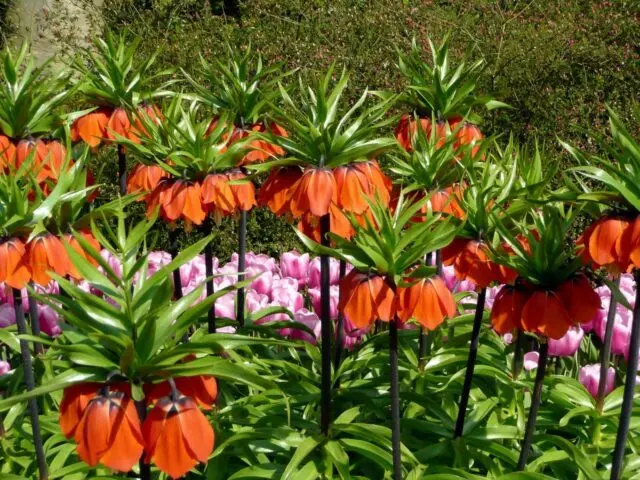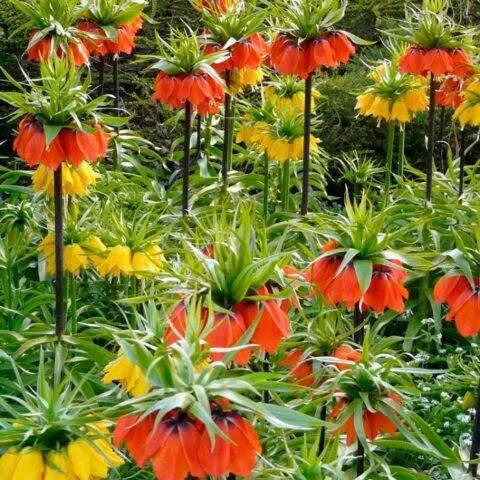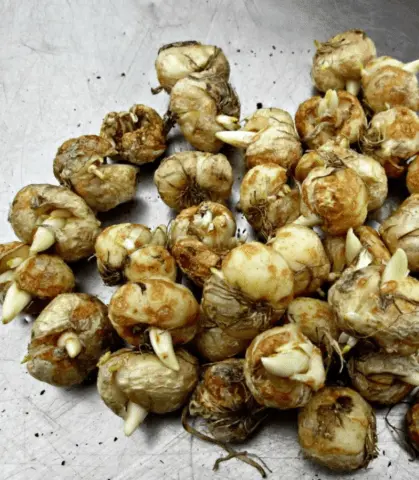Contents
Planting hazel grouse in the fall in open ground is not only possible, but also necessary. This is the most suitable time, because if planted in the spring, the plants may not take root or bloom poorly. The terms and rules of landing for different regions are described in detail in the article.
Features of the autumn planting of hazel grouse
Grouse bulbs (also called fritillaria) are planted in the Moscow region and all other regions, including the south, in autumn. This is the only acceptable period, because if you start work in the spring or summer, problems may arise:
- Bulbs planted at the wrong time will not have time to take root well before the onset of frost, and then they may die in the winter.
- Only in the dormant stage and at low soil temperatures can hazel grouse form normal flower buds.
- To ensure normal conditions in the spring, the planting of hazel grouse would have to be carried out very early, literally after the snow melted. In practice, this option is difficult to implement even in the south, not to mention other regions. Returning spring frosts can lead to the death of almost all bulbs.
- Another reason why it is right to plant hazel grouse in the fall is related to the development cycle of the bulbs. During spring and summer, they will not be able to accumulate enough nutrients and get stronger by the first frost. Therefore, the bulbs do not fully ripen, they can die in winter. And even if they survive, flowering will be rather scarce.
Planting in the fall has quite a lot of advantages, but there are also disadvantages. The main drawback is related to the fact that you need to accurately determine the timing. If frosts come too early and then recede (sometimes even Indian summer comes after that), then the bulbs can suffer greatly.
Therefore, when planting, you need to focus on the fact that the deadlines are compressed – hazel grouses need at least 3-4 weeks of stable heat. If you start work earlier, then the flowers will grow and freeze, and if later, they will not have time to take root and suffer from frost.

In order for the plants to bloom well, they should be planted only in the fall.
When to plant grouse in the fall in open ground
When planting hazel grouse in the fall, it is very important to determine the timing. As a rule, they fall on warm time – mainly in September, and in some areas even at the end of August. But if, according to the forecast, autumn will be dry and not cold, work can be started in the first half of August. Specific dates depend on the weather forecast and climatic features of the regions:
- The optimal time for planting hazel grouse in the fall in the Moscow region, other areas of the middle lane is the first half, mid-September.
- In the south, landing begins in late September or early October.
- Grouse should be planted in autumn in the Leningrad region and other regions of the North-West at about the same time as in the Moscow region, and in the northern regions – a week earlier.
- In the Urals, in Siberia and in other areas with severe winters – from mid-August to the first decade of September.
How to plant a hazel grouse in the fall before winter
After you managed to decide on the timing, you need to prepare the place in advance. You will need to dig and fertilize the soil. The day before planting, start preparing the bulbs. The more carefully you approach the preliminary work, the better the tubers will take root, and the more flowers they will give for the next season. The main rules are described below.
Site Selection
Before planting grouse bulbs in the fall, you need to choose the right place for the flower bed. It must meet several requirements:
- sunny, open, while slight partial shade from shrubs is allowed;
- lack of stagnant water (melt, rain, after watering). The landing site should be located on a small hill, and the lowlands should be excluded;
- fertile, loose soil – light loam with a slightly acidic or neutral pH of 6-7 is well suited;
- as far as possible protected from strong winds, especially from the north side of the garden.

Grouse grows well in lighted flower beds
Fritillaries look good along the fences, framed by paths, the borders of different zones of the flower garden. They can be used in rock gardens and other beautiful compositions.
Soil preparation
Soil preparation begins 1-2 months before planting in the fall, approximately at the end of July. The surface of the flower bed is cleaned and dug onto a spade bayonet. To fertilize the soil, add a bucket of compost or humus per square meter. If the soil is clay, close up sand, sawdust or peat up to 3 kg for the same area.
Bulb preparation
Before planting fritillaria in the fall, it is necessary to prepare the bulbs. Unlike tulips, daffodils, gladioli, grouse tubers are very heavy and can even reach 500 g. Beforehand, they must be carefully examined:
- crush with your fingers – the surface should be hard enough, not leave dents;
- absence of scratches, other mechanical damage, rot and other symptoms of diseases.
Sometimes small roots appear on the bulbs as the grouse begins to sprout. This does not mean that they should be planted as soon as possible – if the roots are no more than 3-4 cm, you should not rush. But if the roots have become too long, then when planting in the fall they must be shortened. Otherwise, they will break and may rot.
Also on the corms there may be remnants, traces of a dried stem. This is quite normal – you should not cut them off. It is better not to injure the planting material in any way in order to avoid the appearance of open wounds.
Directly on the day of planting, hazel grouse should be pickled in a solution of potassium permanganate (1 g per 1 liter, hold for 20-30 minutes). If it is not there, you can use “Fundazol”, “Fitosporin” or other fungicides (strictly according to the instructions). No other preparation is required – immediately after disinfection, you can start rooting.
The scheme of planting hazel grouse in the fall
As already mentioned, hazel grouse bulbs are very large, therefore, the depth of their planting in the ground in the fall should be maximum. The indicator is calculated individually – it should be three bulb heights. For example, if the tuber is 5 cm, then it is planted 15 cm, and if 10 cm, respectively, 30 cm.

Small bulbs can be planted at a depth of 15 cm
The landing scheme is quite simple – you need to act like this:
- Corms are sorted by size into 2-3 groups.
- Several large holes are marked 40-50 cm wide with the same interval (tight fit). If space allows, it can be placed at a distance of 60-70 cm.
- A small layer of drainage is laid at the bottom – small stones, sand.
- Then a layer of fertile soil is laid – literally 2 cm.
- 5-6 tubers are placed on this layer at once in each hole – this is a normal practice for hazel grouses. It should be laid at a slight slope, trying to straighten the roots (if any).
- Sprinkle with sand up to 3 cm, then put fertile soil again and fall asleep to the surface level.
- Water with settled water, then lay the mulch.
Grouse care in the fall after planting
Care after landing is quite simple. Grouse in the fall do not need abundant watering, but they must be carefully covered for the winter and fertilized once. Particular attention should be paid to shelter for the winter. No matter how deep the hole is, the earth itself will not save you from frost. Therefore, plantings must be carefully mulched. The main rules are described below.
Watering
Watering is given immediately after planting. It should be moderate – 5-7 liters per square meter. Preliminary water is settled at room temperature for 10-12 hours. If the autumn is rather dry and warm, two weeks after planting, hazel grouses can be given another watering in a very small volume – 3-4 liters per 1 m2.
Additional fertilizing
If the soil was fertilized before planting the bulbs in the fall, it is not necessary to make any additional top dressing. If the soil is infertile, black peat and a pinch of wood ash can be poured into it. For next year, standard top dressing is introduced. In the spring they give nitrogen compounds, and during flowering – complex fertilizers or superphosphate with potassium sulfate.
Shelter
Particular attention should be paid to the shelter of hazel grouse for the winter. A week before the first frost, it is necessary to lay out a layer of mulch with a height of at least 12 cm (in the Urals, in Siberia, in the Far East – 20 cm). These can be different materials:
- straw;
- lapnik;
- chips;
- hay;
- sawdust;
- pine needles;
- humus.

Wood chips and other materials can be used for mulching
Shelter is removed immediately after the snow cover melts. It is necessary to hurry and not leave the protective layer for too long. Otherwise, the bulbs will overheat due to excess moisture.
Conclusion
Planting hazel grouse in the fall in open ground is quite simple. First you need to prepare a flower bed, as well as the bulbs themselves. They are selected, inspected and dressed in a fungicide. Then planted in pre-prepared deep holes, watered and mulched. How to properly plant hazel grouse in the fall is also described in the video.









